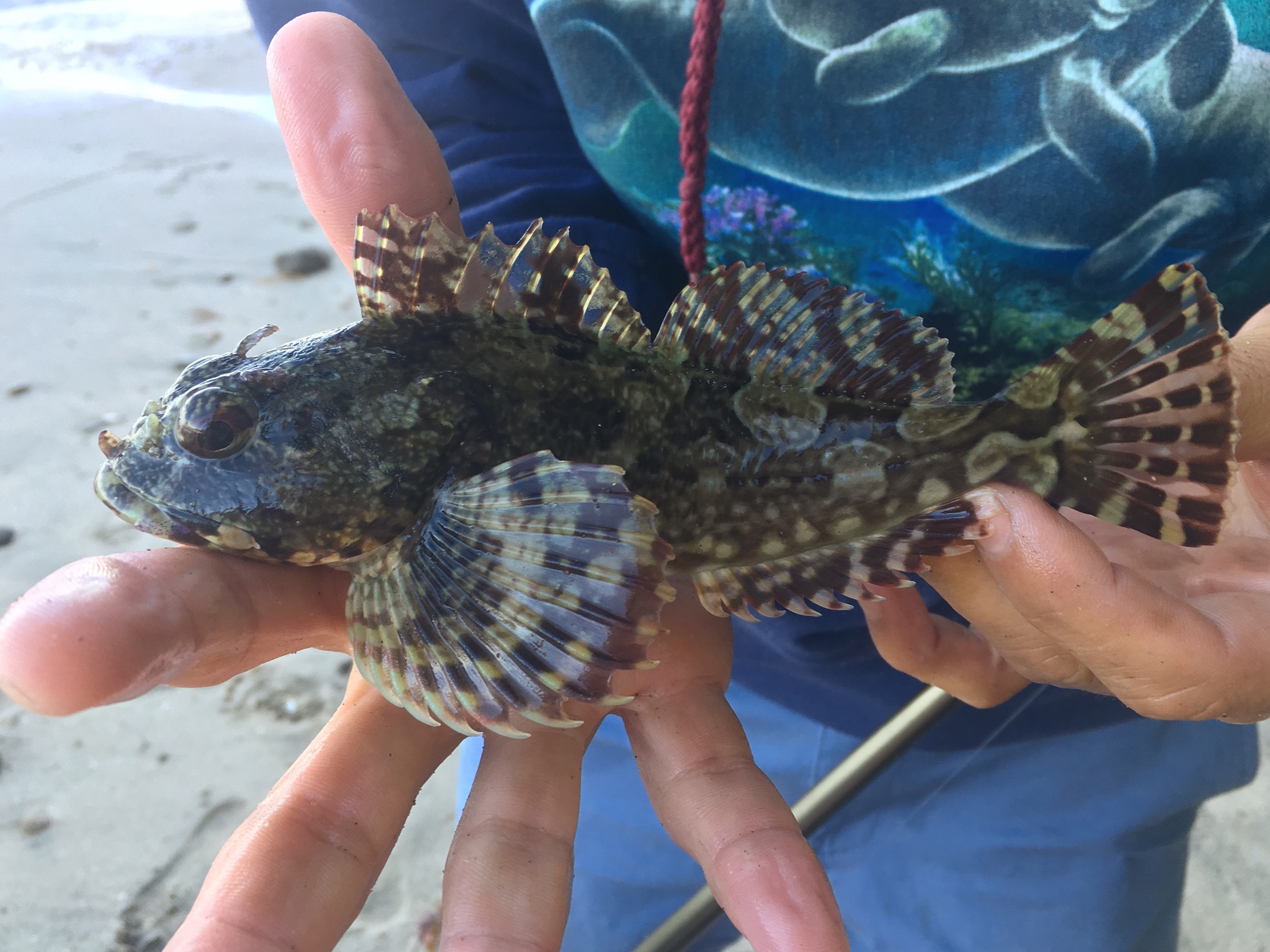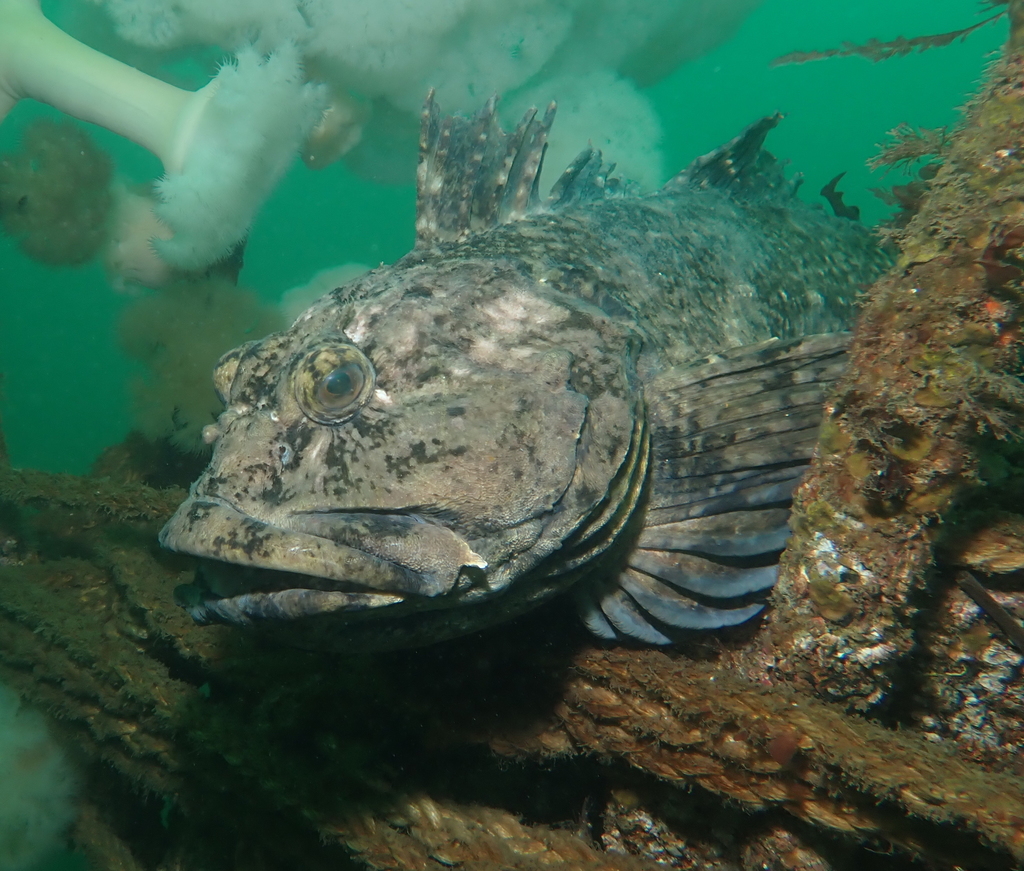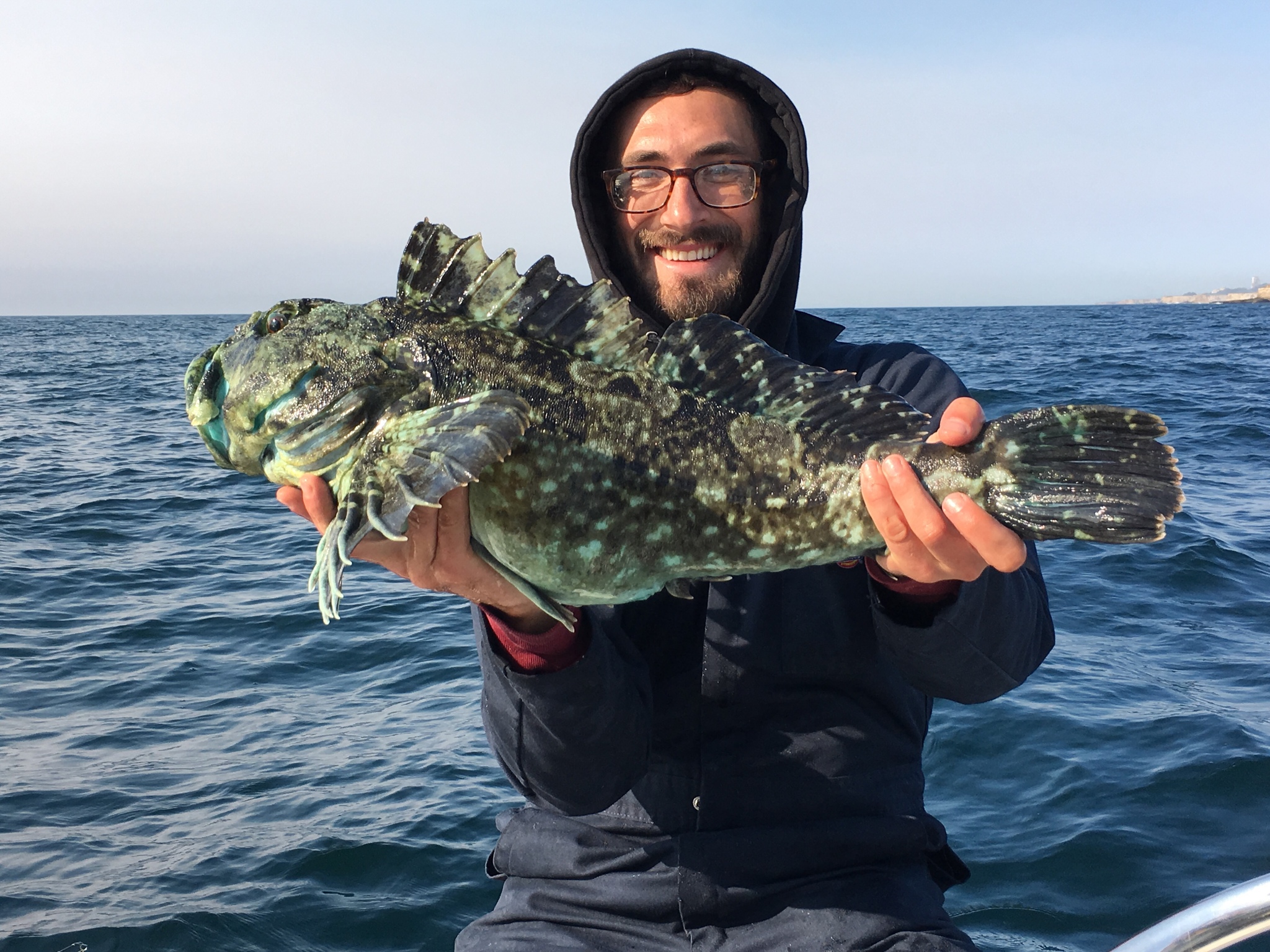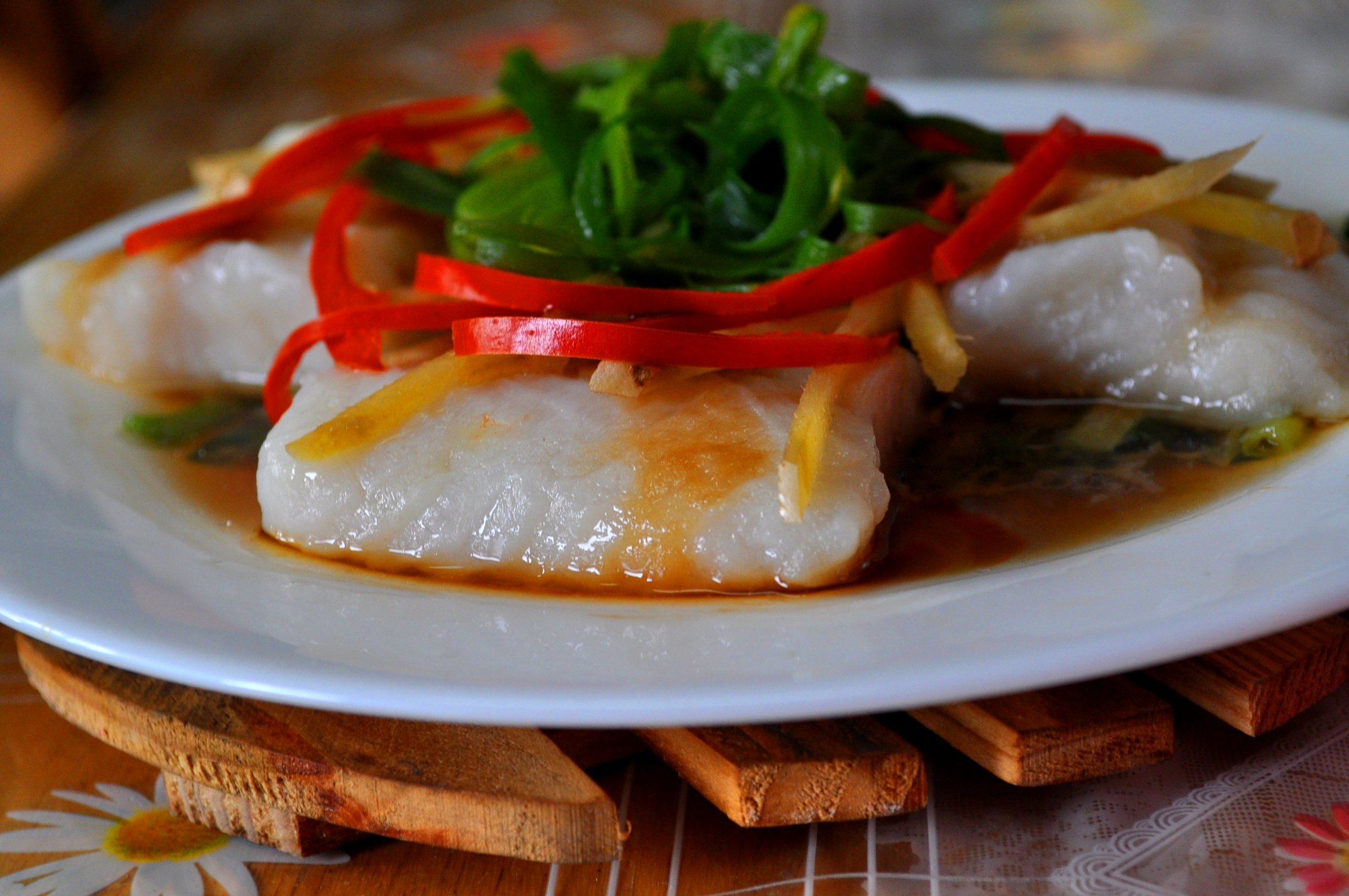Scorpaenichthys marmoratus
North Coast (Oregon Border to Point Arena)
North Central Coast (South of Point Arena to Half Moon Bay)
Central Coast (South of Half Moon Bay to Point Conception)
Santa Barbara (Point Conception to Point Dume)
South Coast (Point Dume to Mexico border)
Flakey fish
Wild caught

The Science

Taxonomic description
- The name “Cabezon” comes from Spanish meaning "large head", which is a main identifying feature for this fish. [1]
- Grows up to 1 m (3 ft) in length and weigh over 11kg (24 lbs). Females are usually larger than males of the same age. [1]
- Ranges in color with varying shades of brown, red, or green with lots of darker mottling to help with camouflage. Females are usually greenish while males are more reddish. [1]
- Has smooth skin without scales, which distingushes it from lingcod. [1,2]
Distribution
- Found from the Eastern Pacific, from North Alaska to central Baja California, Mexico. [2]
Life history
- Adults spawn on rocky outcrops in shallow water, and males guard the eggs until they hatch. [3]
- After hatching, the larval young drift out to sea then develop into small, silvery fish. [3]
- After 3 to 4 months as larvae, the 3-5cm long fish settle at intertidal pools then move to reefs and kelp forests. [2,3]
Habitat
- Found nearshore from intertidal to 200m (656 ft.) among jetty rocks, kelp forests, and rocky reefs. [3]
- It is ambush predator that patiently waits for passing by prey, then lunges to engulf its prey with its large mouth. [1]
- Predators of this fish include larger fish and marine mammals. [2]
- Prized as a recreational game fish. [3]
The Fishery

Seasonal availability
- Caught commercially year-round except for the months of March-April, during which the fishery is closed. [9]
Regulatory and managing authority
-
Managed federally by the NOAA fisheries and, as established by the Magnuson-Stevens Act, the Pacific Fishery Management Council (PFMC) through the Pacific Coast Groundfish Fishery Management Plan (FMP). [6]
-
As established by the Marine Life Management Act, the California Fish and Game Commission (CFGC) regulates the fishery in state waters, and the California Department of Fish and Wildlife (CDFW) manages this fishery through the California Nearshore Fishery Management Plan (NFMP). [7]
-
The Groundfish Collective combines input from the industry and government entities to inform regulatory and/or management measures for this fishery. [13]
Gear type
- Caught commercially with hook and line, pots and traps. [3]
Status of the fishery
- There is little data about this fish relative to other groundfish. [3]
- Most fishing pressure comes from recreational fishing, in particular by Commercial Passenger Fishing Vessels, which increased access to nearshore fisheries starting in the late 1930s. [3]
Potential ecosystem impacts
- All environmental concerns regarding various methods of fishing apply. [11]
- There is not much concern over current levels of exploitation because of the cabezon's wide distribution, size limits on catch, and little demand for the fish. [3]
The Seafood

 Edible portions
Edible portions
- Most of the fish can be eaten, except for the roe (eggs), which are poisonous to people. [1]
Description of meat
- The cabezon has blue colored flesh that turns white when cooked. [1]
- It has sweet, shellfish flavored meat that can be prepared in almost any manner. [1]
Culinary uses
- This versatile fish can be prepared in many ways: fried, baked, grilled, or steamed. [1]
- For some cooking suggestions for cabezon, visit ehow.com. [12]
Nutritional information
-
No nutritional information available, shown is information for Lingcod, a fairly similar species as described by those who fish and eat this fish. [10]
Toxicity report
- Although the rest of the fish is delicious, the roe (eggs) are toxic when consumed. [1,5]
Seasonal availability
- Available year-round except for March-April. [9]
References
[1] Jones, K. Cabezon. 2018. Pier Fishing in California. Web. https://www.pierfishing.com/cabezon/. Accessed 21 Aug 2020.
[2] California Marine Sportfish Identification: Other Fishes. 2013. California Department of Fish and Wildlife. Web. https://wildlife.ca.gov/Fishing/Ocean/Fish-ID/Sportfish/Other-Fishes#cab.... Accessed 12 July 2017.
[3] Cope, J. M. Key,. 2009. Status of Cabezon in California and Oregon Waters as Assessed in 2009. California Department of fish and Came c/o National Marine Fisheries Service. Fishery Resource Analysis and Monitoring Division Northwet Fisheries Science Center. Web. https://stacks.stanford.edu/file/druid:wp142gt6325/Cabezon09_FINAL.pdf Accessed 1 May 2017
[4] California Dept. of Fish and Game, 1953. The Life History of the Cabezon, Scorpaenichthys Marmoratus (Ayres). Web. https://www.dfg.ca.gov/marine/pdfs/response/cabezon.pdf. Accessed 30 May 2017.
[5] O’Connell, CW. 2014. Acute human tpxicity after the ingestion of cabezon, Scorpaenichthys marmoratus, roe. Web. https://www.ncbi.nlm.nih.gov/pubmed/25089726. Accessed: 12 July 2017.
[6] Pacific Coast Groundfish Fishery Management Plan. 2019. Pacific Fishery Management Council. Web. https://www.pcouncil.org/documents/2016/08/pacific-coast-groundfish-fish.... Accessed 21 Aug 2020.
[7] California Dept. of Fish and Wildlife, 2017. Nearshore Fishery Management Plan. Web. https://www.wildlife.ca.gov/Conservation/Marine/NFMP. Accessed 12 July 2017
[8] Cope, J.M. et al. 2019. Pacific Fishery Management Council. Assessing Cabezon (Scorpaenichthys marmoratus) stocks in waters off of California and Oregon, with catch limit estimation for Washington State. Web. https://www.pcouncil.org/documents/2019/10/assessing-cabezon-scorpaenich.... Accessed 21 Sept 2020.
[9] California Dept. of Fish and Wildlife, 2017. State Managed Commercial Fisheries: Cabezon, Greenlings, and Sheephead. Web. https://www.wildlife.ca.gov/Fishing/Commercial/CGS. Accessed 12 July 2017.
[10] Cabezon, Web. Nutritionvalue.org. Accessed 21 Sept 2017.
[11] Fishing and Farming Methods. n.d. Monterey Bay Aquarium Seafood Watch. https://www.seafoodwatch.org/ocean-issues/fishing-and-farming-methods. Accessed 21 Aug 2020.
[12] Allonsy, Amelia. How to Cook a Cabazon Fish. n.d. eHow. Web. https://www.ehow.com/how_8197470_cook-cabazon-fish.html. Accessed 21 Aug 2020.
[13] California Groundfish Collective. n.d. Web. http://www.cagroundfish.org/#our-story. Accessed 28 October 2020.
[14] Thiebaud, S. iNaturalist. 2021. Digital image. Web. https://www.inaturalist.org/observations/69344304. Accessed 12 February 2021.
[15] whologwhy. flickr. 2011. STEAMed FISH. Digital image. Web. https://www.flickr.com/photos/hulagway/5403389312/. Accessed 12 February 2021.
